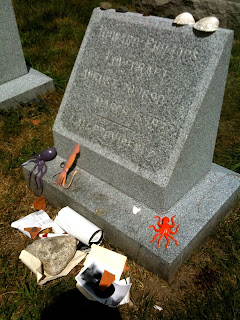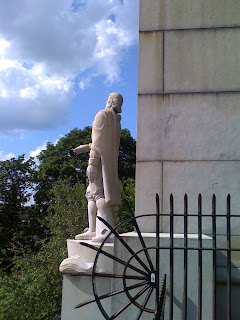Swan Point Cemetery, off Blackstone Boulevard in Providence, is a stunning place of rest. Occupying 200 acres on the shores of the Seekonk River, it includes driving roads, walking paths, and areas for contemplation.
Swan Point was founded in 1846, and planned as a "garden" cemetery. Winding carriageways and paths were laid out to give the appearance of a park, and shrubs and trees were planted to enhance the natural contours of the land. Today it is listed on the National Register of Historic Places, and includes family mausoleums, monuments of various sizes, newer areas with ground-level markers, an urn garden, and a chapel.
Blackstone Boulevard, a long and elegant divided road with a central mall, was designed by Horace Cleveland in 1886, at the request of Swan Point, and the cemetery gave 11.5 acres of land to the City of Providence for that purpose.
There are many famous Rhode Islanders buried at Swan Point, including 10 Civil War Generals, and 23 former governors of the state. General, and later Governor, Ambrose Burnside (perhaps best-known for giving his name to his facial hair decoration--sideburns) falls into both categories.
Among the other Civil War veterans buried there is Major Sullivan Ballou, who was one of 847 Union and Confederate soldiers killed in the first major battle of the war, the first battle of Bull Run, on July 21, 1861.
Ballou left behind a letter to his wife Sarah, which was made famous by Ken Burns' Civil War film.
O Sarah! If the dead can come back to this earth and flit unseen around those they loved, I shall always be near you; in the garish day and in the darkest night-amidst your happiest scenes and gloomiest hours-always, always; and if there be a soft breeze upon your cheek, it shall be my breath; or the cool air fans your throbbing temple, it shall be my spirit passing by.
Sullivan and Sarah lie side by side at Swan Point. My sister-in-law (a professional voice-over artist) read the text of the letter while my brother played the "Ashokan Farewell" on his iPhone. I had brought along the letter but the performance was spontaneous and extremely moving.
One of our favorite monuments was the Edgar John Lownes memorial monument, a bronze sculpture on a marble base located along a path that dips down to the river right around the corner. It was created in 1924 by Vienna-born Isodore Konti. (Konti had emigrated to the US in the 1890s to work on sculptural decorations for the Columbian Exposition in Chicago in 1893.)
Lownes, who was born Edgar Lowenstein but anglicized his name during a period of anti-German sentiment during WWI, had founded the American Silk Spinning Company in 1908, and was also a local philanthropist. Among other organizations, he was involved in a volunteer capacity with both Brown University and the Rhode Island School of Design. (Two of his sons graduated from Brown University, and his portrait hangs in the Brown Faculty Club.) In his will, Lownes had asked that a casting of Konti's Genius of Immortality be placed over his grave. At the request of Lownes' wife Teresa, Konti added wings to his original design, and two relief plaques of angels.
My final featured grave is that of H.P. Lovecraft, a horror, fantasy, and science fiction author, whose headstone is littered with objets left by admirers--octopi, shells, stones, and little notes and quotes from his writings. Lovecraft was not very well-known during his lifetime, and was close to poverty by the time of his death. But there has been a resurgence of interest in the intervening years; Lovecraft's Wikipedia entry states:
According to Joyce Carol Oates, Lovecraft — as with Edgar Allan Poe in the 19th century — has exerted "an incalculable influence on succeeding generations of writers of horror fiction". Stephen King called Lovecraft "the twentieth century's greatest practitioner of the classic horror tale." King has even made it clear in his semi-autobiographical non-fiction book Danse Macabre that Lovecraft was responsible for his own fascination with horror and the macabre, and was the single largest figure to influence his fiction writing.
Illustration Credits and References
Photos by Catherine Hurst and Rick Beyer.
The Scultpure of Isodore Konti 1862-1938 by Hudson River Museum.
Swan Point Cemetery Visitor Guide and Map.
Saturday, August 20, 2011
Monday, August 1, 2011
Roger Williams at Prospect Terrace Park
Yesterday I took some visitors on a tour of some Providence sites, and on our way home we made a spontaneous detour to visit the statue of Roger Williams at Prospect Terrace Park. This statue can be seen from a number of points around the city, and its location on a steep hillside overlooking the city offers panoramic views (though they are a bit overgrown!)
Roger Williams was, of course, the founder of Providence Plantations in 1636, and that history will be the subject of another post.
Plans to construct the statue were initiated in 1850, when the Providence Association of Mechanics and Manufacturers raised $100 to that end. A decade later, Williams descendant Stephen Randall organized the Roger Williams Monument Association to raise funds for a memorial. Only a little over $1,100 was contributed. Eventually Randall deposited $1,000 in an account earmarked for that purpose in his will--it was to be left to accumulate (as would the monies raised by the Association) until there was enough to construct a memorial.
The park itself (minus a monument) was developed in 1867.
It was not until 1934 that a renewed effort (led by a new Roger Williams Memorial Association) was begun, with the hope that a monument could be build as part of the city's 300th anniversary in 1936.
Randall's will had two requirements for the funds he had contributed--first that the statue be designed specifically for Prospect Terrace, and secondly that it be tall enough to be seen from far away. The Association held a contest for a design that would meet those criteria, and the winning proposal was submitted by architect Ralph T. Walker and sculptor Leo Friedlander. (Friedlander is probably better known as the sculptor of the two Arts of War figures of men on horseback that flank the entrance to the Arlington Memorial Bridge in Washington, DC.)
The original design called for the statue of Williams at the highest point in the park, and a stairway connecting the upper part of the park to the lower, where two figures of Native Americans would appear by the side of a reflecting pool. This second part was never built.
The statue as constructed is 14 feet high, and carved from Westerly granite. It shows Williams standing on the bow of his canoe with his right hand extended as if blessing the city he founded.
The monument was paid for by a combination of Randall's funds, the original Association's funds, allocations from the City and the Tercentenary Committee, and donations from private individuals. It was finally dedicated on June 29, 1939. Two boxes were placed in the base--one containing various documents related to the statue and its history, and one containing Williams' remains.
The park itself is a bit scruffy, and the view from the site could be significantly improved with some judicious tree work on the slopes below. The monument, especially the structures surrounding the statue, could also use a good cleaning. But it is still a lovely, if somewhat hidden, gem in the city and a photo of the monument similar to my photo at the top of this post appears on the cover of the Providence 375th anniversary guidebook.
In 2006, Roger's hands were vandalized--someone chopped off all five fingers on the left hand and the thumb of the right. In 2010, this damage was finally repaired by Jim Lawrence and his daughter Ally. Jim, a history major at the University of Rhode Island, who started off his career as a stonemason apprentice, seemed uniquely qualified to do the work, and his daughter Ally, a sculptor, assisted him with the project. They inserted stainless steel rods into the arms, and built up the area with restoration mortar. Then Ally sculpted the new fingers to match the original statue. You'd never know!
Illustration Credits and References
Sources for this post include: the Rhode Island Historical Society, the Providence Journal, and Brown University.
All photos in this post by Catherine B. Hurst.
Roger Williams was, of course, the founder of Providence Plantations in 1636, and that history will be the subject of another post.
Plans to construct the statue were initiated in 1850, when the Providence Association of Mechanics and Manufacturers raised $100 to that end. A decade later, Williams descendant Stephen Randall organized the Roger Williams Monument Association to raise funds for a memorial. Only a little over $1,100 was contributed. Eventually Randall deposited $1,000 in an account earmarked for that purpose in his will--it was to be left to accumulate (as would the monies raised by the Association) until there was enough to construct a memorial.
The park itself (minus a monument) was developed in 1867.
It was not until 1934 that a renewed effort (led by a new Roger Williams Memorial Association) was begun, with the hope that a monument could be build as part of the city's 300th anniversary in 1936.
Randall's will had two requirements for the funds he had contributed--first that the statue be designed specifically for Prospect Terrace, and secondly that it be tall enough to be seen from far away. The Association held a contest for a design that would meet those criteria, and the winning proposal was submitted by architect Ralph T. Walker and sculptor Leo Friedlander. (Friedlander is probably better known as the sculptor of the two Arts of War figures of men on horseback that flank the entrance to the Arlington Memorial Bridge in Washington, DC.)
The original design called for the statue of Williams at the highest point in the park, and a stairway connecting the upper part of the park to the lower, where two figures of Native Americans would appear by the side of a reflecting pool. This second part was never built.
The statue as constructed is 14 feet high, and carved from Westerly granite. It shows Williams standing on the bow of his canoe with his right hand extended as if blessing the city he founded.
The monument was paid for by a combination of Randall's funds, the original Association's funds, allocations from the City and the Tercentenary Committee, and donations from private individuals. It was finally dedicated on June 29, 1939. Two boxes were placed in the base--one containing various documents related to the statue and its history, and one containing Williams' remains.
The park itself is a bit scruffy, and the view from the site could be significantly improved with some judicious tree work on the slopes below. The monument, especially the structures surrounding the statue, could also use a good cleaning. But it is still a lovely, if somewhat hidden, gem in the city and a photo of the monument similar to my photo at the top of this post appears on the cover of the Providence 375th anniversary guidebook.
In 2006, Roger's hands were vandalized--someone chopped off all five fingers on the left hand and the thumb of the right. In 2010, this damage was finally repaired by Jim Lawrence and his daughter Ally. Jim, a history major at the University of Rhode Island, who started off his career as a stonemason apprentice, seemed uniquely qualified to do the work, and his daughter Ally, a sculptor, assisted him with the project. They inserted stainless steel rods into the arms, and built up the area with restoration mortar. Then Ally sculpted the new fingers to match the original statue. You'd never know!
Illustration Credits and References
Sources for this post include: the Rhode Island Historical Society, the Providence Journal, and Brown University.
All photos in this post by Catherine B. Hurst.
Subscribe to:
Posts (Atom)






